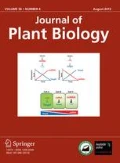Abstract
The glandular trichomes of leaves fromPelargonium xfragrans ‘Mabel Grey’ (Geraniaceae) were examined by light, scanning, and transmission electron microscopy. These trichomes had unicellular globular heads and stalks of different lengths and features. Two types were classified: Type I, with an elongated, large head and a short (100 µm), cylindrical stalk that was more apparent on the adaxial surface; and Type II, with a spherical, small head and a long (300µm), conical stalk that was more pronounced on the abaxial surface. The ultrastructure of secretory cells from both types was distinguished by a well-developed endoplasmic reticulum, mitochondria, plastids, dictyosomes, and numerous vacuoles that likely were involved in the storage and transport of lipophilic substances. Plasmodesmata were frequent on the walls of the secretory and stalked cells. Here, we discuss the implication of structural differentiation in these trichomes.
Similar content being viewed by others
Literature cited
Antunes T, Sevinate-Pinto I (1991) Glandular trichomes ofTeucrium scorodonia L.: Morphology and histochemistry. Flora185: 65–70
Ascensao L, Marques N, Pais MS (1997) Peltate glandular trichomes ofLeonotis leonurus leaves: Ultrastructure and histochemical characterization of secretions. Intl J Plant Sci158: 249–258
Ascensao L, Mota L, Caastro M (1999) Glandular trichomes on the leaves and flowers ofPlectranthus ornatus: Morphology, distribution and histochemistry. Ann Bot84: 437–447
Ascensao L, Pais MS (1998) The leaf capitate trichomes ofLeonotis leonurus: Histochemistry, ultrastructure and secretion. Ann Bot81:263–271
Bosabalidis AM (1990) Glandular trichomes inSatureja thymbra leaves. Ann Bot65: 71–78
Bosabalidis AM, Tsekos I (1982) Glandular scale development and essential oil secretion inOriganum dictamnus L Planta156: 496–504
Bosabalidis AM, Tsekos I (1984) Glandular hair formation inOriganum species. Ann Bot53: 559–563
Bourett TM, Howard RJ, O’Keefe DP, Hallahan DL (1994) Gland development on leaf surfaces ofNepeta racemosa. Intl J Plant Sci1155: 623–632
Bruni A, Modenesi P (1983) Development, oil storage and dehiscence of peltate trichomes inThymus vulgaris L. Nor J Bot3: 245–251
Corsi G, Biasci D (1998) Secretory structures and localization of alkaloids inConium maculatum L. (Apiaceae). Ann Bot81: 157–162
Dell B, McComb AJ (1978) Plant resins-their formation, secretion and possible functions. Adv Bot Res6: 277–316
Dudai N, Werker E, Putievsky E, Ravid U, Palevich D, Halevy AH (1988) Glandular hairs and essential oil in the leaves and flowers ofMajorana syriaca. Israel J Bot37: 11–18
Duke SO, Paul RN (1993) Development and fine structure of the glandular trichomesof Artemisia annua L. Intl J Plant Sci154: 107–118
Fahn A (1988) Secretory tissues in vascular plants. New Phytol108: 229–257
Frey-Wyssling A (1972) Elimination processes in higher plants. Saussurea3: 79–90
Gershenzon J, McConkey, Croteau R (2000) Regulation of monoterpene accumulation in leaves of peppermint(Mentha xpiperita L). Plant Physiol122: 205–213
Hallahan DL (2000) Monoterpenoid biosynthesis in glandular trichomes of Labiate plants,In DL Hallahan, JC Gray, eds, Advances in Botanical Research, Vol 31. Academic Press, San Diego, pp 77–120
Hammond CT, Mahlberg PC (1978) Ultrastructural development of glandular hairs ofCannabis sativa L. (Cannabaceae). Amer J Bot65: 140–151
Hosokawa K, Fukunaga Y (1995) Production of essential oils by flowers ofHyacinthus orientalis L. regeneratedin vitro. Plant Cell Rep14: 575–579
Isman MB (2000) Plant essential oils for pest and disease management. Crop Protect19: 603–608
Kim ES, Mahlberg PG (1991) Secretory cavity development in glandular trichomes ofCannabis sativa L (Cannabaceae). Amer J Bot78: 220–229
Kim ES, Mahlberg PC (1995) Glandular cuticle formation inCannabis sativa L. (Cannabaceae). Amer J Bot82: 1207–1214
Kim ES, Mahlberg PG (2000) Early development of secretory cavity of peltate glands ofHumulus lupulus L (Cannabaceae). Mol Cell10: 487–492
Kim ES, Mahlberg PG (2003) Secretory vesicle formation in the secretory cavity of glandular trichomes ofCannabis sativa L. (Cannabaceae). Mol Cell15: 387–395
Mahlberg PG, Kim ES (1992) Secretory vesicle formation in glandular trichomes ofCannabis sativa (Cannabaceae). Amer J Bot79: 166–173
Mahlberg PG, Kim ES (2004) Accumulation of cannabinoids in glandular trichomes ofCannabis (Cannabaceae). J Indus Hemp9: 15–36
Oliveira MM, Pais MS (1990) Glandular trichomes ofHummulus lupulus var. Brewer’s Gold: Ultrastructural aspects of peltate trichomes. J Submicros Cytol Pathol22: 241–248
Skocibusic M, Bezic N, Dunkic V (2006) Phytochemical composition and antimicrobial activities of the essential oils fromSatureja subspicata. Food Chem96: 20–28
Stephen O, Duke R, Paul N (1993) Development and fine structure of the glandular trichomes ofArtemisia annua L. Intl J Plant Sci154: 107–118
Turner GW, Gershezon J, Croteau RB (2000) Development of peltate glandular trichomes of peppermint. Plant Physiol124: 665–679
Venkatachalam KV, Kjonaas R, Croteau R (1984) Development and essential oil content of secretory glands of sage(Salvia officinalis). Plant Physiol76: 148–150
Wagner GJ (1990) Secreting glandular trichomes: More than just hairs. Plant Physiol96: 675–679
Werker E (1993) Function of essential oil secreting glandular hairs in aromatic plants of Lamiaceae: A review. Flav Frag J8: 249–255
Werker E, Putievsky E, Ravid U (1985) Essential oils and glandular hairs in different chemotypes ofOriganum vulgare L. Ann Bot55: 793–801
Werker E, Putievsky E, Ravid U, Dudai N, Katzir I (1993) Glandular hairs and essential oil in developing leaves ofOcimum basilicum L. Ann Bot71: 43–50
Wise ML, Croteau R (1999) Monoterpene biosynthesis,In DE Cane, ed, Comparative Natural Products Chemistry, Vol 2. Elsevier Science, Oxford, pp 97–153
Author information
Authors and Affiliations
Corresponding author
Rights and permissions
About this article
Cite this article
Ko, K.N., Lee, K.W., Lee, S.E. et al. Development and ultrastructure of glandular trichomes inpelargonium x fragrans ‘mabel grey’ (geraniaceae). J. Plant Biol. 50, 362–368 (2007). https://doi.org/10.1007/BF03030668
Received:
Accepted:
Issue Date:
DOI: https://doi.org/10.1007/BF03030668




